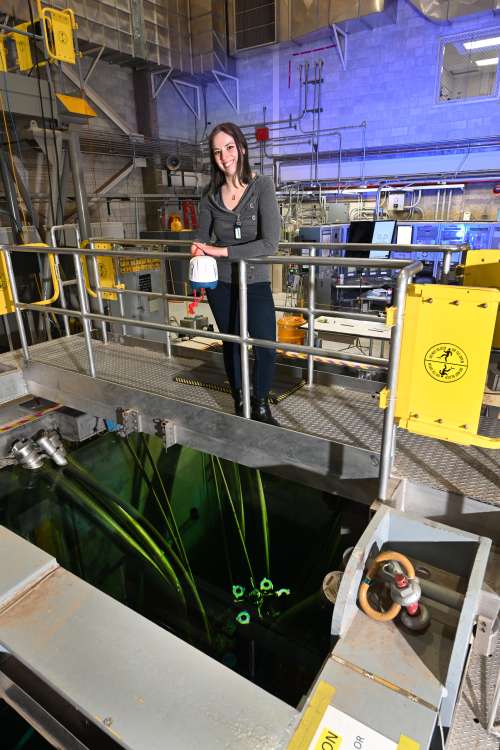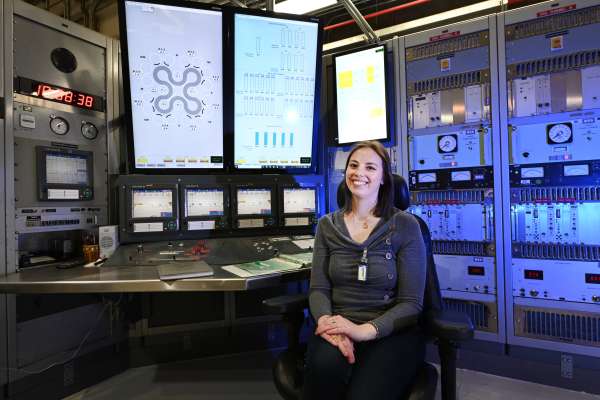Alyssa Spence is now chief operator at Idaho National Laboratory’s Advanced Test Reactor.
This article was originally posted on INL’s website and was written by Paul Menser. It is being shared on the WINning Edge with permission.
Throughout its 75 years, Idaho National Laboratory’s ranks have been filled with multi-generational family members, many of them cases of the apple not falling far from the tree.
For Rob and Alyssa Spence, however, the fact that both work at INL’s Advanced Test Reactor today is where the coincidence ends.
When Alyssa was getting ready to graduate from University of California, Berkeley, she was planning to pursue a career related to environmental and earth sciences, which had been her major. It was only in passing that Rob Spence put a bug in her ear that ATR was looking for reactor operators.
“I knew she didn’t have a typical reactor operator background, but she does best when she has a challenge,” he said. “I knew what to expect and knew she could do it.”
Alyssa said, “Why not?” – she applied then interviewed for an open position and got hired. As a trainer, Rob was partly involved in getting her up to speed but says he has been content to watch her progress at a relative distance.

Six years into her career, Alyssa is now chief operator of Advanced Test Reactor Critical (ATRC), a truly unique and essential part of ATR’s operation. Built in the 1960s at the same time as its high-powered namesake, ATRC has a core identical to ATR’s but operates at roughly 600 watts, compared to ATR’s peak of 250 megawatts. It is used to obtain data on nuclear characteristics of the ATR core, and some new ATR experiments are tested at ATRC before insertion into ATR.
“It’s the test reactor for the test reactor,” Alyssa said. While it takes a team of operators, engineers, radiation control technicians, and reactor instrument and control technicians to operate ATRC, for the most part the duties fall on the reactor supervisor and one operator. “(It’s) more involved – more hands on and less automated,” she said. “You get to see a job through to completion. There’s definitely a sense of pride and accomplishment.”
Carrying the torch
While much has been done in the past 10 years making ATR ready for extended use at least into the 2040s, improvements to ATRC’s instrumentation and controls have been slower. Some of its components date back to the 1960s and 1970s. While upgrades are coming, Alyssa hopes they won’t impede ATRC’s very important function.
Following ATR’s Core Internals Changeout VI, which wrapped up in early 2022, she took part in the first startup, performing tests and large flux runs in ATRC. She and Jim Lowden rebuilt ATRC’s base core to match the changes that had been made to ATR, changing out materials and emptying experiment positions. With new fuel loaded, they collected data on neutron flux distributions, excess reactivities and fuel loading requirements.
“Not everyone is cut out to operate ATRC,” Lowden said. He explained that while the reactor is coming up to power, an operator has about 40 seconds to manipulate and de-select control rod shims, which allow for very precise adjustment of power levels. Any hesitancy could cause data to be lost. The reactor supervisor and reactor operator must have a certain level of nonverbal communication.

“It was her and me,” Lowden said. “She got to play reactor supervisor. She’s fully thrown herself into it, digging into old logbooks from the ‘60s.”
“I do feel lucky Jim stayed around as a trainer instead of retiring like he was initially planning to do, so I am still able to ask him questions if I need to,” Alyssa said. “He has a lot of ATRC knowledge and operating experience that I don’t have quite yet.”
About Idaho National Laboratory
Battelle Energy Alliance manages INL for the U.S. Department of Energy’s Office of Nuclear Energy. INL is the nation’s center for nuclear energy research and development, celebrating 75 years of scientific innovations in 2024. The laboratory performs research in each of DOE’s strategic goal areas: energy, national security, science and the environment.